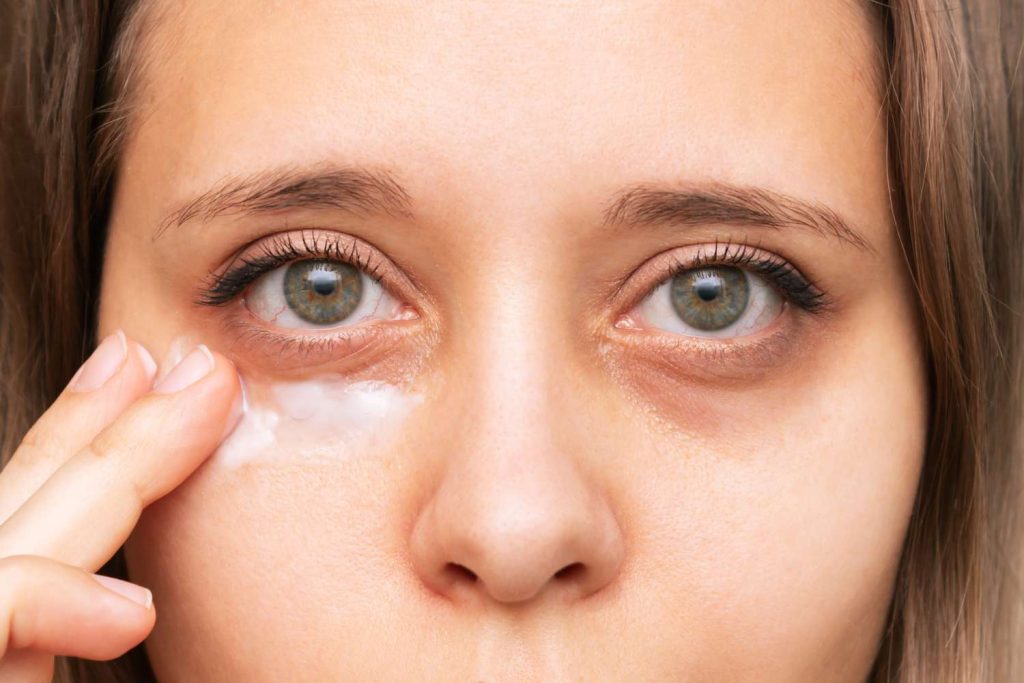Lack of sleep, smoking, and eye rubbing are just a few things that can add to puffy eyes. The tissue around your eyes is particularly delicate and gradually weakens with age. This is why bags under the eyes are more common as you age.
Under-eye bags are usually harmless, but they can make you look tired. There are ways to deal with puffy eyes, whether due to lifestyle or age.
1. Consider an Eye Mask
Cooling the area around the eyes can reduce blood flow, which eases inflammation and swelling. Storing a reusable eye mask in the freezer will make it accessible when you wake up and need quick relief from under-eye bags, dark circles, or eye discomfort. You can also use an eye mask before bed or throughout the day.
2. Make a Cold Compress
Cold compression is one of the most effective methods of soothing puffy eyes. If you don’t have an eye mask, you can make a cold compress by soaking a clean washcloth in cool water and then wringing it out. While sitting upright, gently press the cloth around your eyes for a few minutes.
Cold cucumber slices are a classic choice for soothing puffy eyes. You can also keep a couple of spoons in the refrigerator. Close your eyes and apply the cold item for several minutes for quick relief. Do not place ice or a frozen item (such as a bag of frozen vegetables) directly on your skin, as this risks skin damage. Instead, wrap it in a cloth.
3. Give Under-Eye Patches a Try
Like an eye mask, under-eye patches are easy to use and quickly de-puff those bags. Apply the patches directly to the affected skin and peel them off later. You can wear them before bed, in the morning, or whenever you need a quick refresh.
There are many types to choose from. Some have helpful ingredients such as:
4. Get Some Sleep
Not getting enough sleep is a key factor in morning puffiness, dark circles, and eye bags. Getting adequate sleep is one of the most effective ways to prevent eye puffiness. Some measures that may improve your odds of a good night’s sleep are:
- Avoid using electronic devices before bed.
- Consume less caffeine.
- Get regular exercise.
- Keep light and noise to a minimum in the bedroom.
- Maintain a consistent schedule for sleeping and getting up.
Experts recommend that most adults sleep seven to nine hours a night.
Quickest Solutions
Looking for the quickest solution to under-eye bags? Your best bet is a cold compress, eye mask, or under-eye patch. Sleeping a whole night is one of the most effective ways to avoid puffy eyes in the morning.
5. Elevate Your Head at Night
Raising your head to sleep can lower the chances of fluid settling around the eyes. Elevate the head of the bed by a few inches. If you don’t have an adjustable bed, using a wedge pillow or sleeping on two pillows instead of one can do the trick.
6. Apply Retinol Eye Cream
Applying an over-the-counter (OTC) retinol eye cream at night can improve under-eye puffiness, darkness, and lines. It’s best to use these only at night as they can make skin more sun-sensitive.
7. Take Advantage of Caffeine
Caffeine helps constrict blood vessels and reduce under-eye puffiness, which is why many cosmetic eye creams contain caffeine. Caffeine-containing tea can also help ease puffiness. Just chill caffeinated tea bags over your eyes for several minutes.
Green tea extract has also been shown to have an anti-inflammatory effect that may benefit the eyes.
8. Manage Allergies
If you have seasonal allergies, congestion and inflammation can add to that puffy look and result in dark circles under the eyes, sometimes called allergic shiners. Try to avoid rubbing your eyes and take your allergy medicine as prescribed. See a healthcare provider if your medicine isn’t working or if your eyes are red, itchy, or painful.
9. Pass on the Salt
Too much salt can lead to water retention and swelling, so try cutting back. Avoiding salty foods and not drinking fluids just before bedtime may help reduce fluid retention and eye puffiness in the morning.
10. Reduce Alcohol Consumption
Alcohol has a significant impact on skin and facial aging. Research suggests that eight or more drinks a week is associated with more under-eye puffiness and upper facial lines.
11. Quit Smoking
Smoking can accelerate the loss of collagen (a protein in the skin), making skin under the eyes thinner and blood vessels more visible. Smoking is linked to increased severity of under-eye puffiness, as well as facial lines and wrinkles.
Quitting smoking can help reduce puffiness and prevent under-eye bags from worsening. If you need help, ask your healthcare provider about smoking cessation programs.
12. Apply Sunscreen Around Your Eyes
It’s easy to overlook the area around your eyes when applying sunscreen. However, this area is particularly delicate and easily damaged by ultraviolet (UV) radiation. Sun exposure can also lead to more pigment and dark circles under the eyes.
Consider using facial sunscreen every day. Large sunglasses and a wide-brimmed hat can also help protect the skin around your eyes.
13. Experiment With Antihistamine Eye Drops
Seasonal allergies can cause symptoms such as inflammation and swelling under the eyes. Research shows that proactive use of antihistamine eye drops can help reduce these symptoms.
14. Use Cosmetics
Cosmetics such as concealers will not reduce eye puffiness, but they can temporarily cover any shadows or dark circles that may appear.
15. Assess Your Lifestyle
If you often have puffy eyes, you may be able to determine its cause by asking yourself the following questions:
- Do I push off sleep in favor of electronic screens?
- Do I smoke, drink too much alcohol, or eat a lot of salty foods?
- Do I tend to retain water or rub my eyes frequently?
These are just a few culprits that can contribute to puffiness around the eyes. Genetics, aging, and allergies can also affect baggy eyes. Take a mental walk through your daily routine to find risk factors you can modify.
16. Look Into Health Conditions
Some health conditions, such as thyroid problems, can cause eye swelling. If home remedies do not help and you don’t know what’s causing the eye puffiness, it’s worth seeing a healthcare provider to rule out any underlying health conditions.
A Word From Verywell
If over-the-counter treatments are not helpful, if you develop symptoms like itching or a rash, or if the appearance of your skin is negatively impacting your quality of life, see a board-certified dermatologist for evaluation and treatment of eye bags and swelling.
:max_bytes(150000):strip_icc()/BrendanCampMD-127aa53bf22f45849115b5ccd4ba0413.png)
Summary
Applying a cold compress is the quickest way to get rid of bags under your eyes. A good night’s sleep is one of the best ways to prevent them. Other methods include using eye creams, managing allergies, and reducing or eliminating alcohol use.
Bags under the eyes are usually temporary and not cause for concern. But if they’re a frequent problem or you have other symptoms, such as redness, dry eyes, or itchiness, a healthcare provider can help determine the cause and potential solutions.








